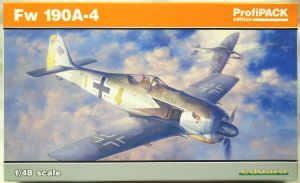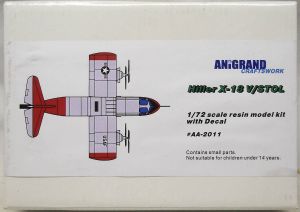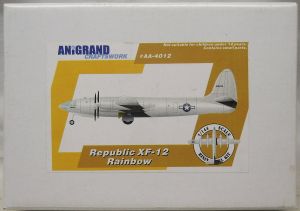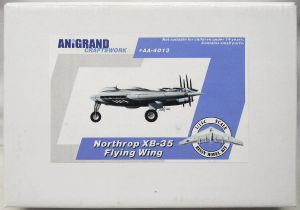Friulmodel Sherman T54E 1 Type Metal Working Tracks, 1/35, ATL-12
Metal Model Kit, Box Condition: Exc

$49
Rare. Very highly detailed, fine cast metal track set T54E 1 type for the Sherman tank. Includes 200 links in 1/35 scale and wire for the track pivots. Never started and the parts are still in the internal factory sealed bags and includes instructions.
Eduard Focke Wulf Fw-190 A-4 Profipack - (Fw190A-4), 1/48, 82142
Plastic Model Kit, Box Condition: Exc

$34
Extremely detailed and well molded kit that features all very fine recessed panel lines, colored photoetched parts, pre-cut masks, decals for five aircraft, very well detailed cockpit, gear wells, separately molded rudder and ailerons and much more. Never started and the parts are still in the internal factory sealed bags and includes decals and instructions.
Azur Vultee V-11 Attack Bomber - FAB Brazilian Air Force / Turkish or Chinese Air Forces - BAGGED, 1/72, A039
Plastic Model Kit, Box Condition: No Box
$42
NOTE: bagged kit; there is no box. The box is shown for reference only. Dated 1997. High quality limited issue kit with resin details and decals for all three air forces. Never started. All resin and photoetched parts are still factory sealed; the injection molded parts have been inventoried complete. Includes decals and instructions.
Azur Vultee V-1 A Spanish Republican Bomber - Spanish Republican Air Force Gruppo 72 1937 / Spanish Republican Air Force Gruppo 1938 - BAGGED, 1/72, A038
Plastic Model Kit, Box Condition: No Box

$65
NOTE: bagged kit; there is no box. The box is shown for reference only. Very rare and dated 1997. High quality limited issue kit with resin details and decals for two modified bombers. Never started and the parts are still in the internal factory sealed bags and includes decals and instructions.
Monogram Mercury Capsule and Atlas Booster - Young Astronauts Issue, 1/110, 5910
Plastic Model Kit, Box Condition: Good++
$62
Young Astronauts Issue with poster. From highly detailed ex-Revell molds. The single greatest model kit for the Mercury Atlas program. Contains highly detailed Atlas/Mercury, launching pad, ramp, tractor transports, nitrogen tank and trailer. The kit has never been started. Half of the parts are still factory sealed. The other half is not sealed and has been inventoried complete. Includes decals and instructions.
Addar F3D Skyknight and F4D Skyray - 2 in 1 (Ex Aurora/Comet), 901
Plastic Model Kit, Box Condition: Sealed Mint
$34
Still mint in the factory seal. From ex-Comet (and ex-Aurora) molds. Addar was an attempt by ex-Aurora employees to carry on the name when Aurora went under. The Skyray is 1/88 scale and the Skyknight is 1/99.
Anigrand Hiller X-18 V/STOL, 1/72, AA-2011
Resin Model Kit, Box Condition: Exc

$52
Very highly detailed, high-definition cast resin kit of this unique aircraft. The parts are still in the internally sealed bags. Includes decals and instructions. During early 1955, Hiller Aircraft designed a large, tilt-wing VTOL aircraft as an in-house study. In 1956, U.S. Air Force showed interest in this concept and assigned a contract to Hiller for the development of a VTOL cargo transport. The test bed was designated X-18. In order to speed the construction process and to conserve available Air Force funding, the X-18 was built from many existing materials, such as the fuselage from Chase C-122, the turboprop engines from the XFV-1 and XFY-1 and miscellaneous parts from the R3Y. The prototype was completed and started to proceed with ground testing in 1958. A year later, it made first flight without any difficulty. After a total of 20 flights were completed, the Air Force ended its flight-testing and set the X-18 aside for ground tests to develop a database for the upcoming XC-142 transport project. In 1964, the X-18 was disassembled for scrap.
Anigrand Republic XF-12 Rainbow - (XR-12), 1/144, AA-4012
Resin Model Kit, Box Condition: Exc

$70
Very highly detailed 1/144 scale resin kit of this beautiful aircraft. The parts are still in the internally sealed bags. Includes decals and instructions. The Rainbow was not only beautiful but was very fast with a top speed of 460 MPH. Designed as a long range high speed reconnaissance aircraft for the Pacific theater, the design was brilliant and successful. However, the USAAF decided to use modified B-29s (RB-29) instead.
Anigrand North American YF-93A, 1/72, AA2039
Resin Model Kit, Box Condition: Exc

$48
Very highly detailed resin kit. It has never been started. The parts are still in the internally sealed factory bags. Includes decals and instructions.
Anigrand Martin XB-16 Winged Whale, 1/144, AA4016
Resin Model Kit, Box Condition: VG

$78
This is a highly detailed resin model. Never started. The parts are still in the internal factory sealed bags and includes decals and instructions. In 1933, the U.S. Material Division at Wright field began a study for a modern bomber that would able to carry 2500-lb bomb load form 5000 miles and 200mph. This specification was then submitted to the War Department as Project-A and received tentative approval. In 1934, the USAAC began contract negotiations with Boeing and Martin. The specifications called for a long range bomber capable of the destruction by bombs of distant land or naval target, and the ability to reinforce Hawaii, Panama and Alaska without the use of intermediate servicing facilities. Martin submitted Model 145 and was accepted to built a XB-16 prototype. The aircraft was similar in size to the Boeing XB-15, but was to use four Allison liquid-cooled engines instead of air-cooled radial engines that normally used on bombers in the 1930s. In order to increase the range and bomb load, Martin revised the XB-16 design making it much bigger. The wing span was increased to 173 feet and six engines were used, four on the leading edge and two on the trailing edge. The XB-16 was considered as being too large and expensive, and the project was canceled before anything could be built.
Anigrand Northrop XB-35 Flying Wing, 1/144, AA4013
Resin Model Kit, Box Condition: Exc

$74
This is a highly detailed resin model. Never started. The parts are still in the internal factory sealed bags and includes decals and instructions.
Anigrand McDonnell YC-15, 1/72, AA2126
Resin Model Kit, Box Condition: Exc

$145
Well detailed high-definition cast resin model with recessed surface detail. The kit has never been started. The parts that were factory sealed are still in the sealed bags. The large parts that were never factory sealed have been inventoried complete including decals and instructions. In 1972, the U.S. Air Force issued the Advanced STOL transport program for a new medium airlifter that capable of operations into battle zones with short, temporary airfields. Two proposals were accepted for construction as the Boeing YC-14 and McDonnell Douglas YC-15 prototypes. McDonnell Douglas's design incorporated a supercritical wing, the result of NASA research. The design team also chose to use externally double-slotted flaps to direct part of the jet exhaust downwards, while the rest of the exhaust passed through the flap and then followed the downward curve due to the Coanda effect. Two YC-15s were built, the first flight was on 26 August 1975. The second prototype followed in December. The Air Force decided it needed a larger transport that would fly to standard, conventional airfields rather than into battle zones. In 1979, the Air Force formally cancelled the AMST program for both the YC-14 and the YC-15. As a result, the C-X program, the C-17 evolved.
Anigrand Bartini-Beriev VVA-14M1P, 1/144, AA4044
Resin Model Kit, Box Condition: Exc

$64
Sells for $88 new. This is a highly detailed resin model. Never started. The parts are still in the internal factory sealed bags and includes decals and instructions. In late 1950s, the U.S. Navy started the Polaris program which ultimately armed US submarines with ballistic missiles. The USSR quickly issued a requirement for an Anti-Submarine-Warfare system to counter this urgent threat. The Minister of Defense selected Bartini's floatplane design and ordered Beriev OKB to build three prototypes. It was to be developed in three phases. The VVA-14M1 was to be a technology test-bed with inflatable pontoons. The VVA-14M2 was to be more advanced with fly-by-wire flight controls. The third stage would be the VTOL vehicle fully equipped with weapons. In 1972 the first prototype made its first flight. In 1974, the inflatable pontoons were installed but the expansion and retraction caused many problems. They were later replaced by rigid pontoons and the fuselage was lengthened and a pair of 'starting' engines were added. The program continued in 1974 but the engine vibrations caused breakage of the landing gears and rear control flaps. Beriev was given higher-priority work with the A-40 and IL-78, so the program was terminated. Only the one prototype was produced.
Anigrand Yakovlev Yak-24 Horse, 1/72, AA2088
Resin Model Kit, Box Condition: Exc

$52
Highly detailed model with high-definition cast resin parts. Never started. The parts are still in the internal factory sealed bags and includes decals and instructions.
Anigrand Ilyushin Il-102, 1/72, AA-2107
Resin Model Kit, Box Condition: VG

$62
Very highly detailed resin model. Never started. The parts are still in the internal factory sealed bags and includes decals and instructions.
Tamiya Bristol Beaufighter Mk.VI Night Fighter, 1/48, 61064-2800
Plastic Model Kit, Box Condition: Sealed NM

$32
Still factory sealed. Very highly detailed. Features all fine recessed panel lines, detailed cockpit and crew station, two crew members, detailed engines, optional position canopy and more.
Italeri Mil Mi-8 / Mi-17 Hip - USSR / Poland / SAR West German Army, 1/72, 021
Plastic Model Kit, Box Condition: Sealed Exc

$20
Still factory sealed. Detailed kit with numerous pieces featuring complete cockpit, full cargo compartment, optional position entry door, weapons load, parts for either version and painting guide and decals for the three helicopters listed.
Italeri M-107 Mad Dog - Self-Propelled Howizter - South Vietnam ARVN / British / US 2nd Bat 32nd Art Vietnam 1969 / Unknown US Unit Vietnam / Israeli Defence Forces In Southern Lebanon / US 2nd Bat 5th Art Germany 1964 / US 8th Bat 4th Art Vietnam 1969 - (M107), 1/35, 248
Plastic Model Kit, Box Condition: Good+

$58
Very highly detailed and nicely molded kit. Features many working parts and decals for all listed. Never started. The parts are still in the internal factory sealed bags and includes decals and instructions.
Aurora Douglas M-2 Mailplane - Western Air Express CAM Route, 1/48, 111-98
Plastic Model Kit, Box Condition: VG+

$69
First issue dated 1957 with classic Jo Kotula artwork. Molded in deep gloss burgundy and black plastic. Never started and inventoried 100% complete with all parts, decals and instructions present. This aircraft has a fascinating history. From the internet: The United States Post Office had been running the air mail service since 1918 mainly using variants of the de Havilland DH.4 biplane. In 1925, it decided to modernize and placed an order with Douglas for a replacement aircraft based on the Douglas O-2 observation biplane. The company modified an O-2 by covering over the forward cockpit to make a mail compartment and moving the pilot into what had been the observer's cockpit. The aircraft was designated the DAM-1 (Douglas Air-Mail-One) but this was soon shortened to M-1. The M-1 used the same Liberty engine as the DH.4, which was available in large numbers. Small modifications were made to the exhaust system to keep fumes away from the pilot and the design was considered a success, but was not ordered into production. When the Contract Air Mail (CAM) routes were introduced, the newly formed Western Air Express Company (later Western Airlines) ordered six mailplanes with the designation M-2. The main change from the M-1 was that the tunnel radiator was replaced with a frontal type. It also had the provision to carry a passenger instead of mail in the front cockpit. Just before Western Air Express introduced the aircraft into service (in April 1926 from Los Angeles to Salt Lake City), the Post Office ordered 50 aircraft designated M-3 for its major route network. The M-3 had only detailed differences from the M-2.
ESCI AD-4W Fleet-Eye - Skyraider Early Warning Platform - US Marines VMC-1 'Guppy' Korean War 1950 / Royal Navy AEW1 849 Sq A Flight 1956 Suez Crisis, 1/48, 4046
Plastic Model Kit, Box Condition: VG
$32
Fleet Airborne Early Warning Radar Platform from the pre-E2C Hawkeye days. Nicely molded with very fine raised panel lines, 'good' cockpit and engine detail, drop tanks, two piece canopy and decals for the Royal Navy and US Marines. Never started. The parts are still in the internal factory sealed bags and includes decals and instructions.
